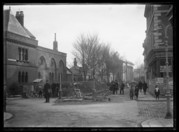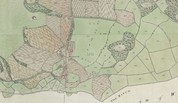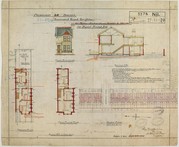|
Would you like to view the web page version of this email? Click here
|
|
|
|
|
|
|
Early 20th-century Lewes captured on camera, plus talks, events and digitisation news
|
|

Our Archive of the Month is a collection of about 750 glass plate negatives that were donated to East Sussex Record Office. The images were taken by Henry John Bartlett (1878-1965) of 14 Morris Road, Cliffe, Lewes. The negatives had previously been stored in a damp garden shed, in brown envelopes which held their descriptions; unfortunately,
some of the envelopes stuck to the plates, resulting in the deterioration of the image or loss of the description. What survives, however, is a fascinating record of life in and around Lewes from around 1900 to 1930.
It is thought that Bartlett, a solicitor’s clerk, took up photography in the 1890s, but never tried to make a living from it. He did publish some of his photographs anonymously as postcards. His collection is particularly rich in images of First World War soldiers camped around Lewes, Bonfire celebrations and topographical views. You can read more about the archive on our website. The images themselves can be viewed on computers in the Reference Room (reference ACC 8509), so do pop in and take a look. And keep an eye on our Twitter and Facebook pages, as we'll be sharing some of these lovely pics throughout the month!
Pictured: Friars Walk, Lewes, with the road dug up, possibly for the laying of gas pipes, c1912 (ACC 8509/322)
|

We're delighted to be welcoming local historian Paul Jordan to The Keep on Wednesday 26 February, when he will talk about the impact of the Second World War on Eastbourne. It has been described as one of the worst-bombed towns on the south-east coast, and Paul will discuss how local residents coped with life in wartime, from rationing to the blackout. The talk will start at 5.30pm, with an archive display from 5pm.
There's still time to reserve a place at our talk on the cultural history of stress on 12 February. Dr Jill Kirby will be exploring this fascinating subject to see if modern life really is more stressful that it was in the past. Advance booking is essential for both talks; you can find more info and booking details on the Events pages of our website.
Pictured: bomb damage to Eastbourne Library during WW2
|

It's rare for a day to go by at The Keep without a number of people asking to view a digitised copy of an East Sussex tithe map. Tithes were taxes paid to the local church and the maps were drawn up after the Tithe Redemption Act of 1836, when 'in kind' payments were converted to money payments. These wonderful maps are useful for local, family and house history, as they provide a visual snapshot of each parish, while the relevant apportionment adds information about who owned and farmed each piece of land. We're delighted that visitors to The Keep can now view the digitised maps on any computer in the Reference Room, which will make them much more accessible on busy days. Please ask staff for guidance if you're interested. You can find more information about tithe maps in the guidance notes on our website.
Pictured: a section of the tithe map for the parish of Glynde, 1839
|

February is LGBT History Month, and we are marking it with a special screening of the BFI's Britain on Film: LGBT Britain. This poignant collection of archive films dating from 1909-1994 includes some of the earliest representations of LGBT people on screen. On the day, there will also be a display of original material from The Keep's archives, highlighting LGBT history both locally and nationally. The screening will take place on Saturday 29 February at 1.30pm (display available to view from 1pm) and advance booking is essential; you can find more information and booking details on the Events pages of our website.
|

Our archives include some wonderful architectural plans for buildings in Brighton & Hove. In the past, each address was allotted a card by the Council when it was first built and the cards in every road were boxed in alphabetical order. On each card was logged the date and reference number of the original plan of the property, with all additional work or changes, each with a planning reference number. The cards are now held by The Keep and are essential for anyone interested in their house history and wanting to find original drawings, drainage plans or details of alterations.
One of our fantastic volunteers, John Phillips, has scanned the property cards in ten boxes out of the 28 we hold, making them available to see in our open-access Reference Room. This will save visitors time as they should easily be able to find the address of the property in question, and staff will then assist them in ordering individual plans to view in the Reading Room, where original archives can be consulted. John says; ‘I’m working at the rate of about a box a week, and it’s a really fiddly job. But I’ve got as far as ‘H’!’
Pictured: plan from our archive for houses in Bernard Road, Brighton, c1901 (DB/D/7/5376)
|
|
|
|
|
|
|